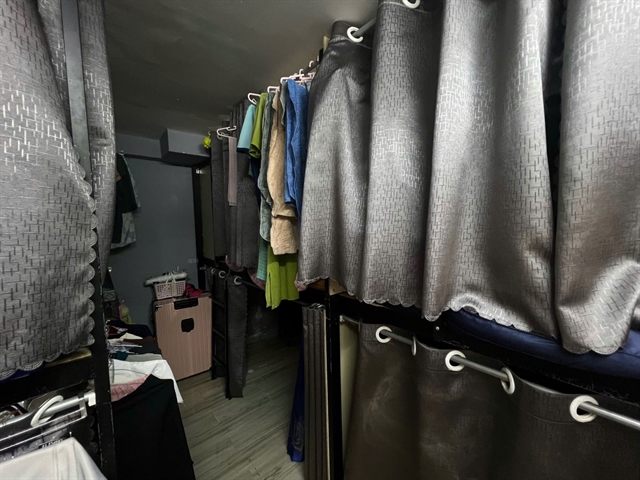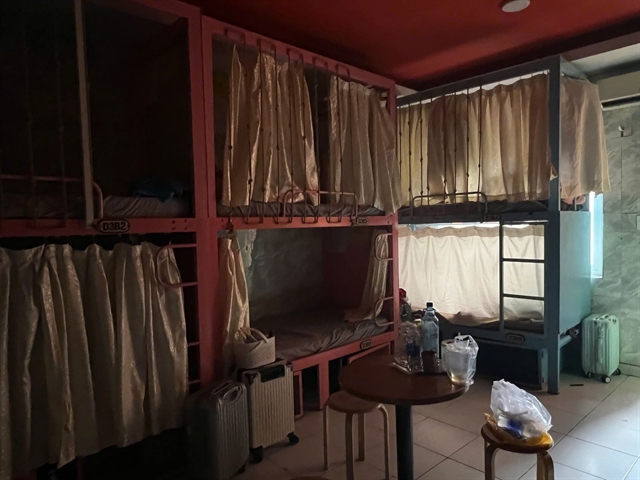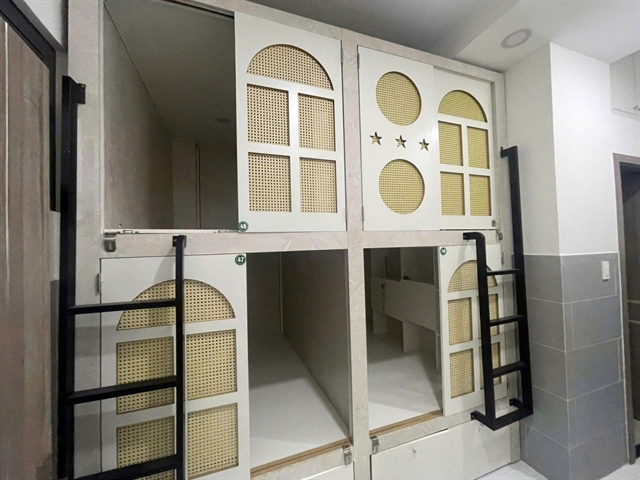 Society
Society


|
| Clothes hanging in narrow passageways between sleepboxes pose a serious fire hazard. — Photos courtesy of student tenants |
HCM CITY — In the past few years, a new kind of student housing has spread rapidly across HCM City – the sleepbox.
Compact, affordable and readily available, these cubicle-style lodgings have become a lifeline for thousands of students who flock to the city for tertiary education.
The appeal is clear. Dormitories fill up quickly, traditional boarding houses can be expensive or complicated to rent, and sleepboxes promise immediate convenience at a bargain price.
For as little as VNĐ1.7 million (US$64) per month, tenants get a pre-furnished unit with bedding, sockets, shared air conditioning and washing machines. Some even boast extras like a small library for students.
"It’s close to school and cheaper than renting a room. The box has enough amenities and its own lock, so I feel secure," said Thùy Dung, a first-year student at the Banking University of HCM City.
One of her parents echoed the sentiment, calling it a practical solution when dormitories are overcrowded: "At VNĐ1.8 million, including utilities and facilities, it seemed reasonable, so I decided to rent it for my daughter."
From Linh Trung to Phạm Ngũ Lão streets, landlords advertise the same promise: just pay a deposit and move in immediately – no extra purchases required. For students arriving from faraway localities, that simplicity is irresistible.
At first glance, some operators appear serious about safety and order. In Linh Trung, each sleepbox is fitted with a private lock, surveillance cameras monitor the shared room and the main door uses Face ID recognition.
The manager insists that these measures protect students’ belongings and prevent intruders from entering.
But conditions vary sharply across the city. On Phạm Viết Chánh Street, a sleepbox facility turned out to be little more than a converted single-story house.
Inside, cubicles are separated only by thin partitions and curtains, with no individual locks – an open invitation for theft.

|
| In some lodgings, only a curtain separates one sleepbox from another, leaving tenants vulnerable to theft. |
This contrast shows the precarious nature of the model. While some students enjoy a sense of security, many others are left exposed.
As one student from the University of Natural Sciences put bluntly: "When I first came to the city, I didn’t know where else to go. Seniors introduced me here. When it comes to the living experience, all I can do is to give a wry smile."
Experts warn that the most serious risks lie in fire safety. Many landlords reassure tenants that their facilities are equipped with fire prevention systems. In reality, most provide little more than a few extinguishers or rope ladders.
Reporters visiting several sites found that almost all relied on ordinary residential staircases to connect floors, without independent emergency exits. In cramped conditions, with clothes and belongings hanging across narrow passageways, evacuation during a fire could be very difficult, potentially leading to catastrophe.
Some managers appear dangerously complacent. At a site in Bến Thành Ward, one reassured tenants that "fires are unlikely to happen" – a remark that highlights the lack of seriousness given to safety.
City regulations require a minimum of 4sq.m per person in rental rooms. Yet in many sleepboxes, space has been cut down to just 2sq.m per box – barely enough to fit a single bed.
Some rooms are subdivided into six to eight boxes, stacked into tiers. Students liken them to plywood coffins or fish tanks, grim nicknames that reflect both the claustrophobia and the danger.
"Each room is usually divided into four boxes, just enough for someone under 1.7m tall to lie down," explained Chí Thành, a sleepbox manager. "It’s very tight."

|
| Cramped sleepboxes stacked on top of each other are likened by students to plywood coffins. |
Such arrangements not only make studying and daily life difficult, but also increase the risks of theft and fire, as dozens of students are crammed into a single converted room.
Even beyond security and fire hazards, shared living conditions pose challenges. Most sleepbox areas rely on communal toilets used by dozens of tenants.
Cleaning, according to managers themselves, often takes place only once or twice a week. Unsanitary bathrooms and crowded facilities raise the risk of disease transmission, undermining students’ health.
Equally worrying is the mental toll.
"If students live long-term in such cramped spaces, it poses risks to both physical and mental health," said Trần Nam, Head of Student Affairs at the University of Social Sciences and Humanities.
"They can easily fall into isolation, with limited opportunities for social interaction, at a stage of life when learning and exchange are crucial for development."
Experts and educators agree that sleepboxes should only ever be considered a short-term or emergency solution. While their low cost and convenience may ease the immediate pressure of finding housing during enrollment season, the trade-offs are severe.
The safer, more sustainable option remains university dormitories, which balance affordability with regulated standards. If dorms are unavailable, students are advised to carefully choose traditional rental rooms near campus, ensuring that they meet basic fire safety, hygiene and security requirements.
For now, the rise of the sleepbox reflects the harsh realities of urban housing in Việt Nam’s largest city: a generation of students caught between affordability and safety, forced to choose between comfort today and potential risks tomorrow. — VNS




